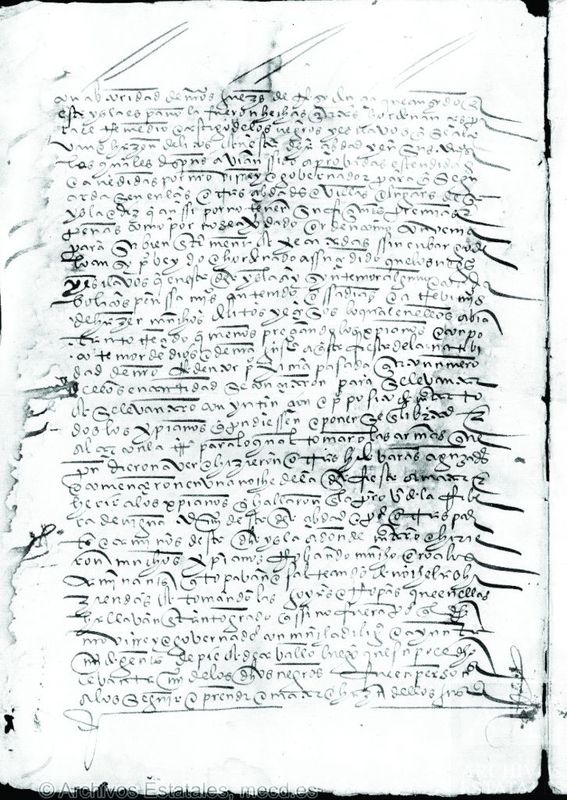The Slaves’ Rebellion of the Christmas of 1521 in La Española
TRANSCRIPTION
con abtoridad de n[uest]ros juez[e]s de r[e]syd[e]nçia que an sido [en] /
esta ysla Española fueron hechas çiertas hordenanças pa /
ra el remedio e castigo de los negros y esclavos q[ue] se alça /
van e hazen delitos en esta d[ic]ha çibdad y en sus [ter]mi[n]os/
las quales d[e]spues avian ssido aprobadas estendidas /
e añedidas por n[uest]ro virrey e gobernador para q[ue] se gu /
ardasen en las otras çibdades e villas e lugares de[e]sa /
ysla e diz q[ue] anssi por no tener sufiçient[e]s premias e /
penas como por no se a[ver] dado orden como convenia /
para su bien [en]t[e]ra ment[e] executadas ssin embargo de /
lo ansy p[r]o veydo e hordenado a ssuçedido que los neg[r]os /
y esclavos q[ue] en esta d[ic]ha ysla ay syn temor alguno e con dia /
bolicos penssami[ent]os an tenido ossadias e atrevimi[ent]os /
de hazer muchos d[e]litos y eçesos lo qual en ellos avia[n] /
tanto creçido q[ue] menospreciando los [crist]ianos e con po /
co temor de dios e de n[uest]ra just[içi]a aq[ue]sta fiesta de la nativi /
dad de n[uest]ro redentor p[r]o xima pasada cierto numero /
de [e]llos en cantidad se conçertaron para se levantar /
e se levantaron con yntinçion e p[r]o posito de matar to /
dos los [crist]ianos q[ue] pudiessen e ponerse [en] libertad e /
alçar con la t[ie]rra para lo qual tomaro[n] las armas que /
pudieron aver e hizieron otras [scratched: h] de varas aguzad[a]s /
e començaron en una noche de la d[ic]ha fiesta a matar e /
herir a los [crist]ianos q[ue] hallaron [en] la prov[inçi]a de la rib /
ra de Nigua t[e]r[mi]no de[e]sta d[ic]ha çibdad e por otras par /
t[e]s e caminos de[e]sta d[ic]ha isla adonde mataro[n] e hirie /
ron muchos [crist]ianos robando mucho oro a los /
caminant[e]s q[ue] topaban e salteando de noche las ha /
ziendas e tomando las joyas e ropas que en ellas /
hallavan [en]tanto grado q[ue] ssi no fuera por q[ue][e]l d[ic]ho /
n[uest]ro virrey e governador con mucha dilig[ençi]a e ayunta /
m[ient]o de gent[e]s de pie e de cavallo luego que supo el d[ic]ho /
levantam[ient]o de los d[ic]hos negros fue en persona /
a los seguir e prend[e]r e matar e haz[e]r de[e]llos just[içi]a /
ENGLISH TRANSLATION
with authority from our residencia judges that have been in this Hispaniola island, certain ordinances were made
for the remedy and punishment of the blacks and slaves that rebelled and commit [sic] crimes in this said city and
within its limits, which later had been approved, expanded, and added to by our Viceroy and Governor, so that
they were complied with in the other cities and villages and places of that Island. And reportedly because of not
having enough coercions or penalties as well as because no order had been issued as it was convenient so they were
thoroughly implemented, in spite of what was thus decided and ordered, it has occurred that the blacks and slaves
that there are in this said island, without any fear and with devilish thoughts, have had the temerity and daring to
commit many crimes and excesses, which had grown so much amongst them that, despising Christians and with little
fear of God and of our justice, that this just passed holiday of the Nativity of Our Redeemer a certain number of
them agreed as a group to rebel and rebelled, with the intention and purpose of killing all the Christians they could
and freeing themselves, and taking over the land, for which they took the arms they could find and made others out
of sharpened rods and, during one night of the said holiday, began to kill and wound the Christians they found in
the province of the Nigua river bank, within the district of this city, and in other parts and roads of this said Island
where they killed and wounded many Christians, stealing a lot of gold from the pedestrians they met, and assaulting
by night the farms and taking the jewels and garments they found in them, so much so that, if it had not been for
our said Viceroy and Governor, with great diligence and gathering of people on foot and on horses, after learning of
the said uprising of the said blacks, going in person to chase and apprehend and kill and bring them to justice,
Commentary
During the Christmas festivities of 1521, a number of slaves, enraged about the oppression they were subjected to, launched a rebellion, violently attacking Spanish settlers and instilling in them a great deal of fear, fed by the notion that the rebelling Blacks aspired to wipe out ‘the Christians’ of the land and become the new rulers of the colony. Colonists had been implementing “certain ordinances” to prevent uprisings, but shortly after the 1521 revolt, on January 6, 1522, the rebellion prompted the authorities, led by Governor Diego Colón, to issue new laws for ‘Blacks and slaves’ in order to prevent any further uprisings.The laws prescribed a combination of restrictions on physical mobility, minimized access to weapons and increased punishment in the form of physical torture such as severance of a foot or by execution. The legislation came to be known as the Laws of 1522.
 Sixteenth-Century La Española: Glimpses of the First Blacks in the Early Colonial Americas
Sixteenth-Century La Española: Glimpses of the First Blacks in the Early Colonial Americas 
